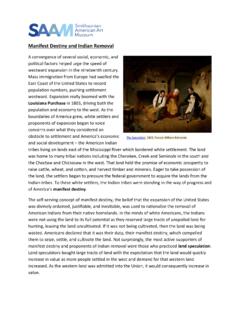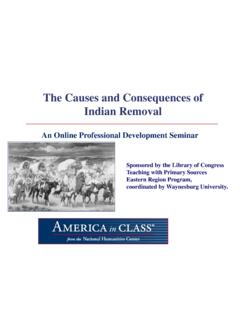Transcription of Ms. Wiley’s APUSH Period 4 Packet, 1800-1840s Name
1 1 Ms. Wiley s APUSH Period 4 Packet, 1800-1840s Name: Page #(s) Document Name: 2-5 1) Period 4 Summary: ?s, Concepts, Themes, & Assessment Info 6-8 2) Timeline 9-10 3) Marbury v. Madison (1803): Establishing Judicial Review 11-14 4) The Monroe Administration (1817-1824) 15-18 5) indian removal Documentary (focus: 1830s) 19-23 6) The jackson Administration (1829-1837) 24-28 7) Market Revolution in the Urbanizing North 29 8) Second Great Awakening 30-36 9) Reform Movements in the North 37-42 10) Education Reform in the North 43-45 11) Intellectual Culture 46-49 12) Southern Society 50-51 13) Utopian Experiments 52-55 14) Comparing North & South (+ a note on the West) 2 Period 4 Summary ( 1800-1840s ) Key Questions for Period 4: - Key tensions emerge in this Period between nationalism vs.
2 Sectionalism and traditionalism vs. modernism. By the end of this Period , was the nation more nationalistic or sectionalized? Traditionalist or modernist? - To what extent did the branches of government expand beyond the contours of the Constitution in this Period ? When were these expansions of power warranted, if at all? - During this Period , did America move closer to, or farther from, American ideals espoused in the Declaration of Independence? - The first half of the 19th century is often heralded as being a more democratic Period than the preceding years. In what ways was American more of a democracy by the 1840s than it had been in the 1790s? - Are the reputations of each president in this Period warranted, or are they in need of revision?
3 - To what extent were the various reform movements of this Period successful, at both the state and national level? - To what extent was the nation headed inevitably towards civil war by the end of the 1840s? Key Concept 1: The United States began to develop more of a democratic nation and celebrated a new national culture, while Americans sought to define the nation s democratic ideals and change their society and institutions to match them. Related Ideas/Examples: - The nation s transition to a more participatory democracy was achieved by expanding suffrage from a system based on property ownership to one based on voting by all adult white men, and it was accompanied by the growth of political parties.
4 O In the early 1800s, national political parties continued to debate issues such as the tariff, powers of the federal government, and relations with European powers. o Supreme Court decisions established the primacy of the judiciary in determining the meaning of the Constitution and asserted that federal laws took precedence over state laws. o By the 1820s and 1830s, new political parties arose; the Democrats, led by Andrew jackson , and the Whigs, led by Henry Clay, which disagreed about the role of the federal government and issues such as the national bank, tariffs, and federally funded internal improvements. o Regional interests often trumped national concerns as the basis for many political leaders positions on slavery and economic policy .
5 - While Americans embraced a new national culture, various groups developed distinctive cultures of their own. o The rise of democratic and individualistic beliefs and changes to society caused by the market revolution, along with greater social and geographic mobility, contributed to a Second Great Awakening among Protestants that influenced moral and social reforms and inspired utopian and other religious movements. o A new national culture emerged that combined American elements, European influences, and regional cultural sensibilities. o Liberal social ideas from abroad and Romantic beliefs in human perfectibility influenced literature, art, philosophy, and architecture. o Enslaved blacks and free African Americans created communities and strategies to protect their dignity and family structures, and they joined political efforts aimed at changing their status.
6 - Increasing numbers of Americans, many inspired by new religious and intellectual movements, worked primarily outside of government institutions to advance their ideals. o Americans formed new voluntary organizations that aimed to change individual behaviors and improve society through temperance and other reform efforts. o Abolitionist and antislavery movements gradually achieved emancipation in the North, contributing to the growth of the free African America population, even as many state governments restricted African Americans rights. Antislavery efforts in the South were largely limited to unsuccessful slave rebellions. o A woman s rights movement sought to create greater equality and opportunities for women, expressing its ideals at the Seneca Falls Convention.
7 Related Themes: - American and National Identity: o Explain how interpretations of the Constitution and debates over rights, liberties, and definitions of citizenship have affected American values, politics, and society. o Analyze relationships among different regional, social, ethnic, and racial groups, and explain how these groups experiences have related to national identity. 3 o Explain how ideas about democracy, freedom, and individualism found expression in the development of cultural values, political institutions, and American identity. - Culture and Society: o Explain how religious groups and ideas have affected American society and political life. o Explain how artistic, philosophical, and scientific ideas have developed and shaped society and institutions.
8 O Explain how different group identities, including racial, ethnic, class, and regional identities, have emerged and changed over time. o Explain how ideas about women s rights and gender roles have affected society and politics. - Politics and Power: o Explain how and why political ideas, beliefs, institutions, party systems, and alignments have developed and changed. o Explain how popular movements, reform efforts, and activist groups have sought to change American society and institutions. - Work, Exchange, and Technology: Explain how patters of exchange, markets, and private enterprise have developed, and analyze ways that governments have responded to economic issues. Key Concept 2: Innovations in technology, agriculture, and commerce powerfully accelerated the American economy, precipitating profound changes to society and to national and regional identities.
9 Related Ideas/Examples: - New transportation systems and technologies dramatically expanded manufacturing and agriculture production. o Entrepreneurs helped to create a market revolution in production and commerce, in which market relationships between producers and consumers came to prevail as the manufacture of goods became more organized. o Innovations including textile machinery, steam engines, the telegraph, and agricultural inventions increased the efficiency of production methods. o Legislation and judicial systems supported the development of roads, canals, and railroads, which extended and enlarged markets and helped foster regional interdependence. Transportation networks linked the North and Midwest more closely than either was linked to the South.
10 - The changes caused by the market revolution had significant effects on society, workers lives, and gender and family relations. o Increasing numbers of Americans, especially women and men working in factories, no longer relied on semisubsistence agriculture; instead, they supported themselves by producing goods for distant markets. o The growth of manufacturing drove a significant increase in prosperity and standards of living for some; this led to the emergence of a larger middle class and a small but wealthy business elite, but also to a large and growing population of laboring poor. o Gender and family roles changed in response to the market revolution, particularly with the growth of definitions of domestic ideals that emphasized the separation of public and private spheres.















